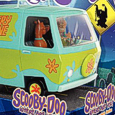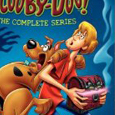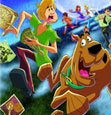Hanna-Barbera (1969-1978), Warner Home Video (November 9 2010), eight disc gift set, 902 mins plus supplements, 1.33:1 original full frame ratio, Dolby Digital Mono, Not Rated, Retail: $79.98
Storyboard:
The four funky detectives of Mystery Inc. and their clever but cowardly pet Great Dane throw themselves into solving a succession of supernatural events that more often than not turn out to be diabolical plots cooked up by a series of elaborately costumed criminals, all of whom might have gotten away with their schemes if it weren’t for those meddling kids!
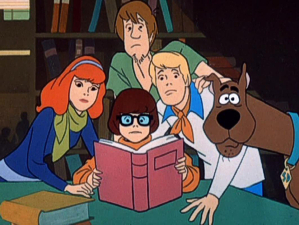
The Sweatbox Review:
For reasons that I won’t bother going into here, there’s practically not a day goes by when I don’t break out into a variation of the Scooby-Doo: Where Are You! theme song, usually with my own lyrics attached to the groovy tune. It’s so indelibly imprinted in my brain from watching the show relentlessly during my childhood that it’s one of the first pieces of memorable music to filter through my head when I absentmindedly begin to hum something. I think the bass line is the hook, just as with so many of the funky tunes television animation producers Hanna-Barbera commissioned for their programs in the 1960s and 70s.
Scooby-Doo quickly became one of the most popular in their library, the simple set up – four kids and their dog solve any amount of supernaturally tinged crimes – meaning an endless supply of stories, all usually following along the exact same lines that has seen the basic concept continue through multiple and numerous reincarnations that continue to play and pull in a substantial following today. But this familiarity was just as the legions of fans liked it, and how better to mark Scooby’s 40th anniversary (technically 2009 but we’re still in that “birthday year”) than to revisit the original series, now gathered in a complete series collection following similar treatment for The Flintstones a couple of years ago.

Actually, comparison to The Flintstones is probably warranted when considering Scooby-Doo: Where Are You!, particularly in terms of its popularity. The Flintstones had, of course, provided Hanna-Barbera with its first prime-time hit show after half a decade of providing safe children’s fare, and it changed how animation was perceived on television, opening the doors for more comedy and dramatic shows including various action series. Scooby-Doo kind of combines all those elements, perhaps losing the adult nature of the characters’ relationships but not resorting to child’s play either: Scooby was another rare thing: an animated hit with teenagers.

The characters’ own ages naturally had much to do with this, though they’re depicted as teens, I always felt they were slightly older and more than probably just out of high school. But this perhaps made them all the more cool to the aimed-for audience and, uniquely, there’s still a strong dynamic between them, from Fred, the hunky football jock who may or may not have a thing going on with Daphne, the redhead high school sweetheart, to the bookish, smart Velma, always one ahead with the clues, and offbeat Shaggy, whose hippy-styled relaxed mentality suggests he’s at least a college drop-out if not necessarily doped-out, even if he’s most connected to Scooby himself (perhaps a reason for, instead of a prevention to, their mutual understanding!).

Now famously (but, for various reasons, never revealed at the time) created by Joe Ruby and Ken Spears during their tenure at Hanna-Barbera (before they left to produce Saturday morning shows under their own name), Scooby-Doo’s strength as a recurring program is also perhaps its weakness. Each show is as cookie-cutter as they come: the fab five of Mystery Inc. will turn up at a deserted hotel/factory/mansion/delete as appropriate, etc, after their spruced up van has overheated/run out of gas, etc, where it soon transpires that there’s a monster/creature/ghost on the loose. The kids split up to investigate, eventually finding that the monster is no such thing, but a ruse to scare off the owners/potential inheritors/benefactors of the location. The monster is ultimately unmasked to reveal an unassuming caretaker/gardener/workman or local figure behind the crime, and they’re dragged off to jail with a cry that they would have been able to pull off their scam if “it weren’t for you meddling kids”!
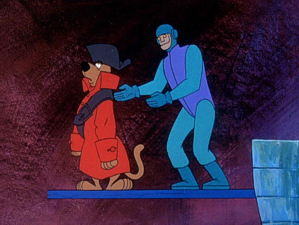
And…that’s it! But the formula worked and kept the show on their air for two seasons, before further variants on the concept were spun off into such programs as The New Scooby-Doo Movies, where Scoob and the gang team up with various celebrities, from Laurel and Hardy to Batman and Robin! In 1978, a third season aired as part of The Scooby-Doo Show, adding a further 16 episodes to Seasons One and Two’s 25, for a 41 episode total under the Where Are You! branding. This third season returned to the more simple nature of the 1969-1970 originals, discarding some additional characters and marking the final point before Scrappy-Doo would make his irritating voice heard, from 1979 and all through the 1980s.
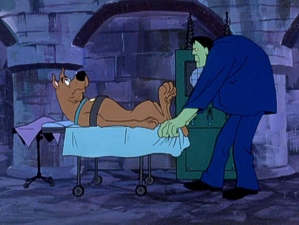
Speaking of voices, the show provides a platform for many of the Hanna-Barbera stock players to make themselves heard, though it’s most notable for featuring animation legend Frank Welker (in a rare character role as Fred) and the vocals of radio announcer Casey Kasem, who had built up a resume of cartoon voices (including Robin in the 1968 Batman animated show) before making it big as the name associated with the American Top 40 chart countdown from 1970 and its various radio and television spin-offs since. He’s the one signature voice over the years that has very seldom changed, and his “C’mon, Scoob” remark is as part of the show as any other ingredient and though the Scooby-Doo feature film cast member Mathew Lillard has now taken on Shaggy duties, Kasem is still attached to the character, voicing his father in the current Scooby-Doo! Mystery Incorporated series.
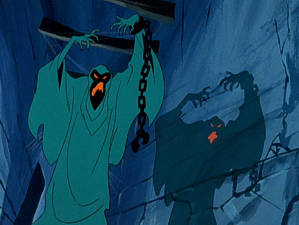
It’s the familiarity of these elements that make Scooby-Doo: Where Are You! so much fun each time out. We know what’s coming…heck, we even know who the culprit is the moment any suspect is introduced (usually the surly, disgruntled employee standing in the shadows!), and we know the pattern of every show. But that just means that, when you come across an episode on TV, you can jump right in without having to catch up. It also means, more unfortunately, that Scooby-Doo: Where Are You! doesn’t really lend itself to un-ending series box set viewing like this! There’s probably more a reason to dip in and out of this collection rather than sit and watch even a full season in one sitting (the best I could manage was a single disc every now and then) since the repetition is even more obvious and, eventually, tiresome.

That’s not to say Scooby-Doo doesn’t work as a show, but it was designed as a weekly excursion into the mysterious and not as a program that could withstand a closer inspection of its otherwise monotonous staging. It sometimes seems the scripts just had their monsters changed: even when dealing with other unlikely stock horror clichés as werewolves, vampires, mummies or even witches and pirates, the usage of the word “ghost” to describe most of them suggests that the text was based on a single template! On the flipside, the artists (under Iwao Takamoto) obviously saw this as a way to run with the creatures’ looks, and if nothing else Scooby-Doo: Where Are You! features an unending supply of actually quite freaky and funky ghost/monster designs that have become as much part of the television animation landscape as anything else and created a genre of its own that is still drawn on today.
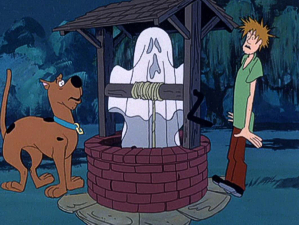
The first season established much of the later work, particularly the first two episodes, the pilot What A Night For A Knight and A Clue For Scooby-Doo. Over the next few shows, the Mystery Inc. gang face up against the phantom of an abandoned castle, an old west ghost town, a haunted mansion, a deserted amusement park (a favorite episode of mine, Foul Play In Funland), a circus’ ghost clown, Frankenstein’s Monster (another favorite, A Gaggle Of Galloping Ghosts, the first to use a preliminary “blasted kids and their dog!” line) and assorted other creatures, aliens and mythical beasts. In these early shows, the reason for its success is clear: Scooby-Doo feels new and fun, with enough variation to keep audiences watching while the antics of Scoob make sure things don’t get too scary for the younger set.
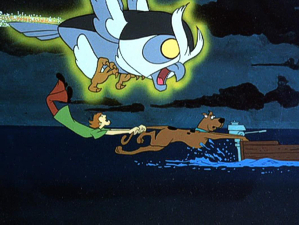
An attempt to keep things fresh in the 1970 second season led to some strange choices, not least the inclusion of “chase songs” by singer-songwriter Austin Roberts, who also re-recorded Larry Marks’ original theme into the one we most associate with the show now. Roberts had been brought in to Hanna-Barbera to provide the bubblegum pop music for Josie And The Pussycats, one of the first shows to emerge in the Scooby mould, and naturally somewhere along the line someone decided his songs would make a good fit for Scooby too. Originally, the Mystery Inc. gang were to have been a pop band on the road (a reply to the success of The Archie Show) so Roberts was no newcomer to the project, having been involved since even before a dog had been introduced to the mix.
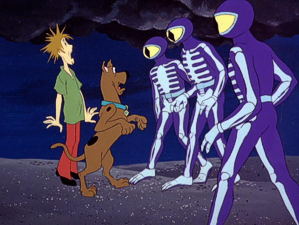
The songs are totally out of place but do bizarrely kind of work, since they’re usually featured in montage sequences that have the gang interacting with the monster of the week, though they’re the biggest thing to date the shows today, like the inserted laughter track, a popular addition at the time. I must admit to not remembering these songs popping up in Scooby when I first saw them, but can see why they were soon dropped again, since they’re too kitschy even for this show! This time around there were only eight episodes, and the formula otherwise stays the same, as the gang meet and defeat Dr Jekyll and Mr Hyde, ancient Chinese legends, a caveman, zombie-phantom The Creeper, and other headless spectres, witchdoctors, werewolves and phantoms (the last, Don’t Fool With A Phantom, being another favorite show of mine).

Following the hour-long New Scooby-Doo Movies, The Scooby-Doo/Dynomutt Hour and Scooby’s All-Star Laff-A-Lympics packaging blocks of the 1970s, all of which doubled up under the generic Scooby-Doo Show title, a third block of six stories reverted to the earlier style of the Where Are You! concept and used the original 1969 credits, with a further ten episodes dropping the Where Are You! titles and being folded into the Scooby’s All Stars block instead, where they would be unseen for many years. Warner Home Video eventually came to these shows’ rescue when it released them as a Where Are You! Season Three collection on DVD, presenting these final sixteen episodes that concentrated on the original Mystery Inc. gang’s exploits between having additional characters making appearances with them, although the 2007 discs somewhat confusingly retained the Scooby-Doo Show titles, with the “hang around for Scooby-Doo” theme tune from the 1970s.

Although very much in keeping with the original two seasons – themselves not terribly consistent – there does seem to be a slight shift in these almost a decade later shows, perhaps an edict from the program’s new network bosses at ABC, where Scooby-Doo had moved from the original CBS. The big change immediately noticed are the animated title cards, which continue typical wordplay and Hanna-Barbera favored reiteration, but at least the whites of the characters eyes haven’t been filled in yet, and we don’t have to put up with Scooby-Dum from the other Scooby-Doo Show segments: if there’s any character more annoying than Scrappy in the Scoobyverse, it’s Dum, who couldn’t even muster up a decent catchphrase, unlike the show’s signature “Scooby-doobie-doo!”, which I’ve always felt is little more than a variation on Hanna-Babera’s “Yabba-dabba-doo!” from The Flintstones but has taken on its own identity all the same.
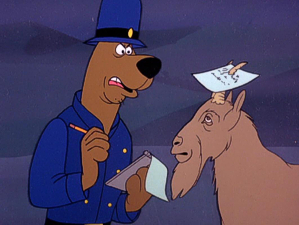
Another subtle swap is to be found in the locations: here Mystery Inc. get to travel the world at large rather than just keep turning up in backwater locals in America (though there’s still that aspect in check too). So we have the globe-trotting gang solving mysterious goings on in the Gulf Stream, the North Pole, Turkey, Scotland, the jungles of Brazil, New York City, China, Venice, Puerto Rico, England and Canada, providing not only a new angle in making sure the visuals don’t get too old too fast, but some fun in spotting how the artists basically throw in some localized architecture, props and “atmosphere” while keeping the show’s basics in check. It’s kind of like, and amusingly so in a charming way, the show stayed on a Californian backlot but still managed to tour the world thanks to the magic of sets and costumes.
Perhaps the “purest” edition of Scooby-Doo: Where Are You! are the original first two seasons, previously assembled by Warner Home Video during the initial release of The Hanna-Barbera Collection sets on DVD. As such, casual fans who may have picked up that edition may feel satisfied to have the pick of the bunch, with the additional “third” season also released in its own set in a later wave. These later episodes don’t really add anything new to the format in themselves, other than an international flavor, but for any rabid Scooby fans out there that continue to cough up for these shows on disc (this particular Complete collection is the third or fourth time out for some episodes by my count) or those that want a sampling of the franchise’s origins, they continue to entertain as the throwaway “mystery of the week” styled outings they were intended as!
Is This Thing Loaded?
As with previous Complete Series editions for The Flintstones and Batman: The Complete Animated Series, this Scooby-Doo set essentially combines the four seasons’ original discs into one newly packaged collection, though rather encouragingly this time (and with the concurrent Batman Beyond: Complete Animated Series box) a special bonus disc has been included so that fans feel they’re getting something exclusive. If you have the previously released season set collections, you’ll be familiar with everything on the first seven discs, which are the exact same editions (complete with the same Season One to Season Four labels and dated previews) as before.

As such, the menus are the same as before, with a nice intro sequence that ends with a basic though fun static image with the characters using their flashlights to highlight the different disc options, while the episode selections themselves place the ghost of the week in the door frame behind Shaggy and Scooby. Back in the early 2000s, these would have seemed pretty neat, but after the intro, the lack of sound (you’d at least expect the theme instrumental to keep playing in the background) and the need to select each option twice – once to highlight it, once to choose it – makes them seem a little clunky now. Season Three now comes on three single sided discs (as opposed to including a double-sided platter), and although the modern-era character menus are less interesting, at least there’s some background music. The discs retain their original season numbering, so Discs One to Four feature the first two seasons, while Discs Five to Seven make up the third.
The extras listed on the back of the box look like a lot of goodness, but in reality they’re largely just that: a lot of bullet points on the back of the box that transpire to be pretty inconsequential. Spread across these discs, we begin with the Scooby-Doo’s Ultimate Fans featurette (11:50), an actually none-too-bad look at three Sc-uber collectors and their phenomenal assortments, even if it’s only tenuously linked to the show. It’s of course natural that the success of Scooby-Doo would have instigated a lot of memorabilia over the years but, you know, I’ve never really thought about it before, so it’s groovy to see the sheer amount of…stuff, though at least one of the guys is pretty spooky in their (and it seems their children, ready or not) exaggerated devotion to the character!
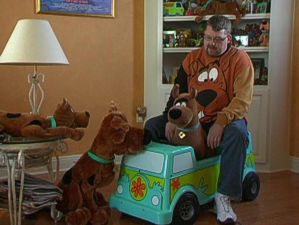
Get The Picture: How To Draw Scooby-Doo And The Gang (2:18) is just what it sounds like, being one of those tutorials that doesn’t really show you how to draw the characters bit by bit but only an artist’s hand creating an image very quickly. It’s a typical clip-art style pose, but Velma seems to have been an afterthought, and is out of place and oversized in the final result. Funky Fashion (4:50) is equally pointless, basically covering the characters’ personalities through their outfits (“how we dress says a lot about who we are”), while an American Loves Scooby-Doo music video (2:30) is merely a random country song (!?) about the gang that features clips from the more modern Scooby shows, where the characters’ white-filled eyes takes away some of the retro look the original Where Are You! show had.
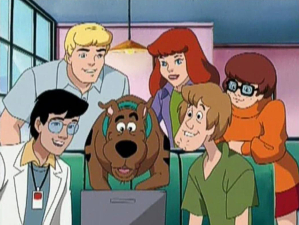
Scooby-Doo Street Smarts (2:45) is the most random yet of the underwhelming extras, in which someone went out with a video camera and asked a lot of people to shout “we love Scooby-Doo!” and tell us about their favorite characters, one girl showing just how much of a fan of the show she is by naming Fred as “whoever that hot guy was with the blond hair”, hmmm… On the back of the box, Take The Scooby-Doo Challenge sounds like it could be a worthwhile trivia trek, but the reality is much more disappointing: just four rather odd multiple-choice questions that, if one gets stuck, can simply be skipped! There’s no context for this quiz (or in some cases the basis for the answers!) and no prize (no exclusive Scooby clip?) for playing, so there’s not much reason to (as with a few now-dated previews for other new Scooby and classic animation titles gathered under a Family Favorites option).
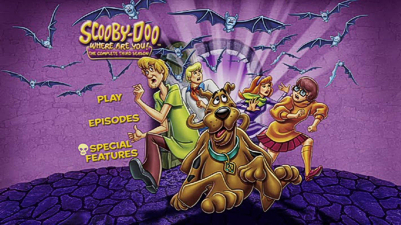
There are further trailers on the final disc of the third season, again for newer Scooby-Doo titles and other Warner animation collections, but the main supplement here – and easily the highlight of this entire set – is the 21 minute Hanna-Barbera: From H To B featurette. With new and archive interviews with many of their collaborators, including the great pair themselves, this is a very nice potted history of the producing duo’s career, primarily focusing on their television years and the creation of their most signature series, although Scooby-Doo does plays a part in their overall story. The closing few minutes increases the connection to this particular show and so while being a generic career retrospective that could be included in any Hanna-Barbera box set, this is as good a place as any to find it, and it’s certainly an essential watch.
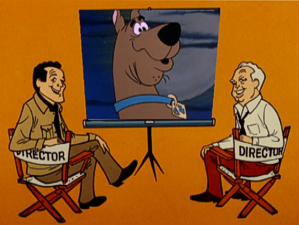
Ultimately, there’s nothing on the originally released season discs that really looks at the creation or production of Scooby-Doo: Where Are You! itself, but the H To B piece does cover the general production process at the Studio. However, that that history is sort of covered in the “all-new” bonus Disc Eight, exclusive to this set. But while the contents are indeed “new” to Where Are You!, some of the material actually appears to be at least partly gathered from other releases (a previously released Scooby/Dynomutt Hour set apparently being the main source). What is all new is the retrospective Scooby-Doo: The Whole World Loves You! featurette (17:22) that, while again less to do with the series itself and more about the Scooby franchise in general, features a lot of good analysis on the basic concept and its worldwide impact.
It’s a fun overview of Scoob’s various incarnations, featuring comments from cast and crew members old and new, and it’s interesting to see animation styles change with each vintage, such as the retro-Johnny Bravo episode, which would have been a natural additional inclusion here (but it’s a no-show). The Eerie Mystery Of The Scooby-Doo History (10:15) finally does describe how the series began as an Archie clone called Mystery’s 5 before becoming a fully-fledged program in its own right, including a more honest portrayal of Ruby-Spears’ involvement, with both “head writers” (as they are credited) and Iwao Takamoto telling their own stories. Lastly, The Scooby-Doo Gang: In Their Own Words (4:50) provides a further few production anecdotes as original voice members share their memories of being cast on the show, but it’s all too brief.
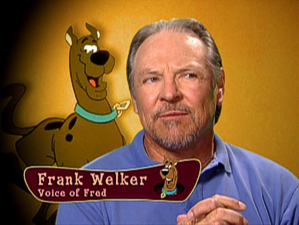
Although these last two appear to have been included on other releases, I nevertheless hadn’t seen these supplements and found them to be among the most worthwhile features in the box. I’m guessing that if fans hadn’t picked up the Where Are You! sets before, they’re less likely to have the Dynomutt collection anyway (indeed, prior to this edition, the only Doo I had on my own shelf was The New Scooby-Doo Movies set), and so while they may not be new to everyone, they’re welcome enough here. However, the more obvious question is: why not include the 18 additional Scooby-Doo Show episodes from the same era that have not yet made any kind of appearance on DVD – or at least the Johnny Bravo referenced episode? Now that may well have provided the big push that would have convinced fans to buy again, even if the fancy packaging outlined below is also a pretty enticing prospect…
Case Study:
 Zoinks! Here’s where Scooby-Doo: Where Are You! The Complete Series scores the most points, tossing out the digipack packaging of the previous season releases for – what else? – the Mystery Machine itself!
Zoinks! Here’s where Scooby-Doo: Where Are You! The Complete Series scores the most points, tossing out the digipack packaging of the previous season releases for – what else? – the Mystery Machine itself!
Long a popular television and movie vehicle as instantly recognisable as the Batmobile, Herbie or The A-Team’s van, the Mystery Machine was in many ways a sixth character in the show, never speaking or acting under its own power, but often the reason the gang broke down or ended up stranded at many of the spooky locations they would inevitably discover needed investigating.
Very well produced, the Mystery Machine is created at a nice scale (roughly 5.0 wide by 8.5 deep by 5.5 high in inches), allowing for a better than expected paint job and character detail. Scooby and Shaggy sit up front in the cab, full-length as one peers inside the windows, and the van itself is sturdily built as well as any toy, and even comes complete with moving wheels, so that fans (who won’t let their kids play with it, I bet!) can drive it around before – or during – watching the show.
The back opens up to reveal a multi-folded, double-sided disc wallet (which list the episode titles including reinstating those for the third season) featuring the DVDs themselves ready to be played and, neatly, these are more accessible than the Flintstones discs in that Complete Series collection.
If I can have just one gripe, it’s that I’d have liked Scooby and Shaggy to be looking outwards to us rather than at each other, which means their faces are turned away and partially “hidden”, and I’d have been tempted to have a “SCOOB-1” printed on the empty license plate, but these really are just small grumbles: this is not only a very nice packaging idea, but also very nicely executed!
Ink And Paint:
Previously described as being remastered transfers, the Scooby-Doo episodes here look as good as they have done on discs released in the past, not least because these are basically reprints of those discs. The term “remastered” is often an interesting one to understand with Warners titles, not least because while they do routinely create new masters for their wide release titles, that doesn’t mean that the original elements are always in the best of shape, meaning that at times we’ve had super-sharp presentations of very aged material. The good news here is that Where Are You! looks remarkably good even given that these prints were transferred earlier in the 2000s and with the moving around of the HB library, they can’t have always been kept in the best of care.

The show’s limited animation style will be well known to most, with cycles and sequences repeated in such a classic Saturday morning television cartoon method that it almost defined the shortcuts that other shows made at the time. However, as usual from WB, compression is absent since they don’t over pack their platters with content (cough…Disney…cough), though I did pick up an almost unnoticeable gamma shift in places. But the remastering really does pick out as much detail as the vintage prints allow, with even the often muted colored backgrounds feeling brighter than I remember and not clashing as much with the primary colored characters. But the darker, atmospheric backgrounds also show up the high levels of cel debris inherent in the original negatives – there as originally photographed and so appropriately preserved here.
Scratch Tracks:
The show’s visual drawbacks inherent in its original production are somewhat evident in the audio side of things, which remains consistent with the modern presentation of the program’s vintage. Thus we have a perfectly preserved mono track with all the narrow dynamics that a mix designed for tinny television speakers of the late 1960s would naturally provide. As with the image, which is never going to receive a full digital restoration that removes all cel scuffs and scratches, the soundtrack to this and a thousand other shows will never benefit from major surround upgrades, but again that’s just as it should be. The important thing is that the sound is suitably genuine to the show, and actually provides much of the nostalgia element in its enjoyment, from the always enjoyable and often groovy stock music scoring, to the bonkers laugh track. English audio is all that is offered, with subtitles provided in English, French and Spanish languages only on the first and second season episodes.
Final Cut:
Apart from any formulaic aspects that might dog the show, Scooby-Doo remains a very profitable franchise for Warner Bros, as evidenced by their assuredness that this collection – coming after single disc compilations, complete series sets and “best of” volumes – was a worthwhile addition to shelves. As with The Flintstones “Bedrock TV” set, the real attraction here for hardcore fans who probably have previous discs is the packaging, though it’s fair to note that since the exact same discs have been carried over from before, you’re also sure of good-as-can-be audio and video quality on the shows, which is surely the main reason for a purchase (well, that and the groovy Mystery Machine package)!
The lack of substantial extras on those original discs is somewhat made up by the new bonus disc, but even here some of that has been recycled and there’s still a lack of anything really enticing (the Johnny Bravo tribute show, the 18 Doo episodes still not on DVD or even a concept art or monsters’ gallery would have been great) for fans to enjoy. But galleries have never been Warners’ strongpoint and to be fair the new bonus disc does add a few decent Scooby Snacks that cover more ground than previously. As such, this collection is the definitive edition of at least the original incarnation, and one of Hanna-Barbera’s biggest hits. Scooby-Doo continues to entertain well past his 40th year, but here’s where it all began for the Scoob and the Mystery Inc. kids – and it looks like they’ll be stopping nefarious criminals getting away with their schemes for many more years to come!
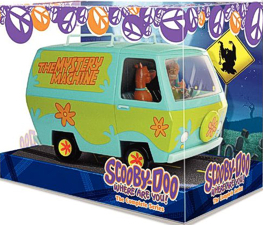 | ||
 |


